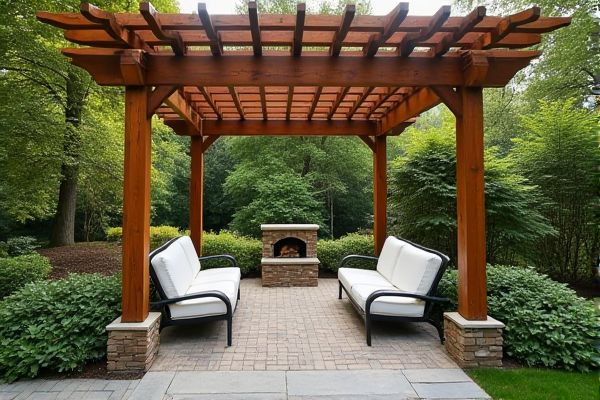
Pergolas offer an open, airy structure ideal for shading and supporting climbing plants, while gazebos provide fully covered, enclosed spaces perfect for protection from weather elements and privacy. Discover which option best suits Your outdoor space and lifestyle by reading the rest of the article.
Table of Comparison
| Feature | Pergola | Gazebo |
|---|---|---|
| Structure | Open framework with cross beams and no walls | Enclosed or semi-enclosed with solid roof and walls or screens |
| Roof | Slatted, allows partial sunlight | Solid, provides full shade and protection |
| Purpose | Garden feature for vines and light shade | Outdoor shelter for seating and socializing |
| Material | Wood, metal, or vinyl | Wood, metal, vinyl, or composite |
| Installation | Usually simpler and less expensive | More complex and costly installation |
| Weather Protection | Minimal, no rain protection | High, protects from rain, sun, and wind |
| Typical Size | Smaller to medium sized | Medium to larger structures |
| Customization | Flexible for plants and lighting | Includes screens, curtains, and built-in seating |
Introduction to Pergolas and Gazebos
Pergolas and gazebos are popular outdoor structures designed to enhance your garden or patio space. Pergolas feature open latticed roofs, allowing natural sunlight while supporting climbing plants, creating a semi-shaded area ideal for relaxation. Gazebos provide fully covered, often octagonal or circular shelters that offer more protection from weather, making them suitable for gatherings and outdoor entertaining.
Defining Pergolas: Features and Functions
Pergolas are outdoor structures characterized by open roofs with cross beams, often supporting climbing plants to provide partial shade and enhance aesthetic appeal. Their design promotes airflow and natural light, making them ideal for creating comfortable, semi-covered spaces in gardens or patios. Your choice of a pergola can enhance outdoor living by combining functionality with decorative greenery.
Understanding Gazebos: Structure and Benefits
Gazebos are freestanding, roofed structures typically made from wood, metal, or vinyl designed to provide shade and shelter in outdoor settings. Their fully covered roofs and often enclosed sides offer protection from rain and sun, making them ideal for outdoor gatherings and relaxation. Gazebos enhance garden aesthetics while providing a versatile space for social events and leisure activities.
Key Differences Between Pergolas and Gazebos
Pergolas feature open, slatted roofs that provide partial shade and support for climbing plants, creating an airy and natural ambiance in your outdoor space. Gazebos have fully covered, solid roofs with enclosed or semi-enclosed sides, offering more protection from weather elements and enhanced privacy. Your choice depends on whether you prioritize ventilation and plant integration with a pergola or shelter and seclusion with a gazebo.
Design Options and Aesthetic Appeal
Pergolas offer an open, airy design with slatted roofs that allow filtered sunlight, creating an elegant and modern outdoor space that complements various garden styles. Gazebos typically feature a fully covered roof and enclosed or semi-enclosed sides, providing a classic and charming aesthetic ideal for protection from the elements. Your choice between a pergola and gazebo depends on whether you prefer a sleek, minimalist look with partial shade or a more traditional structure that offers complete shelter and a cozy atmosphere.
Materials Used for Pergolas vs Gazebos
Pergolas are typically constructed from wood, aluminum, or vinyl, offering a lightweight and open-air design ideal for supporting climbing plants. Gazebos often feature sturdier materials such as treated wood, metal, or composite, with solid roofs for full weather protection and enhanced durability. Choosing the right materials for your pergola or gazebo will affect maintenance needs, longevity, and aesthetic appeal in your outdoor space.
Installation and Maintenance Comparison
Pergolas typically require simpler installation with basic anchoring and may need seasonal cleaning to remove debris, while gazebos often involve more complex assembly with roofing and can require regular maintenance such as painting or stain application to protect against weather. Pergolas usually have open sides, which reduces the risk of moisture build-up but may need periodic sealing to prevent wood damage. Your choice depends on whether you prefer a lower-maintenance, open structure like a pergola or a more enclosed, durable gazebo that demands consistent upkeep.
Cost Analysis: Pergola vs Gazebo
Pergolas generally cost less than gazebos, with average prices ranging from $1,000 to $5,000 compared to gazebos, which can cost between $3,000 and $10,000 depending on materials and size. Pergolas often use cheaper materials like wood or aluminum, while gazebos require more complex construction with roofing and sometimes flooring, increasing labor expenses. Maintenance costs also vary; pergolas need regular sealing or painting, whereas gazebos may incur higher maintenance due to roofing upkeep and potential weatherproofing requirements.
Best Uses and Ideal Settings for Each Structure
Pergolas are best suited for creating shaded walkways, garden paths, or outdoor dining areas where partial sunlight and an open-air feel enhance your experience. Gazebos provide fully covered, enclosed spaces ideal for outdoor entertaining, intimate gatherings, or protection from rain and insects in your backyard or park setting. Your choice depends on whether you prioritize open, airy design with climbing plants or a more sheltered, versatile structure for all-weather use.
How to Choose: Pergola or Gazebo for Your Outdoor Space
Choosing between a pergola and a gazebo depends on your outdoor space needs and desired functionality. Pergolas offer open, lattice-style roofing for filtered sunlight and climbing plants, ideal for creating a shaded, airy atmosphere. Gazebos provide full, solid roofing and enclosed sides, perfect for weather protection and a more private, sheltered retreat in your backyard.
 homyna.com
homyna.com